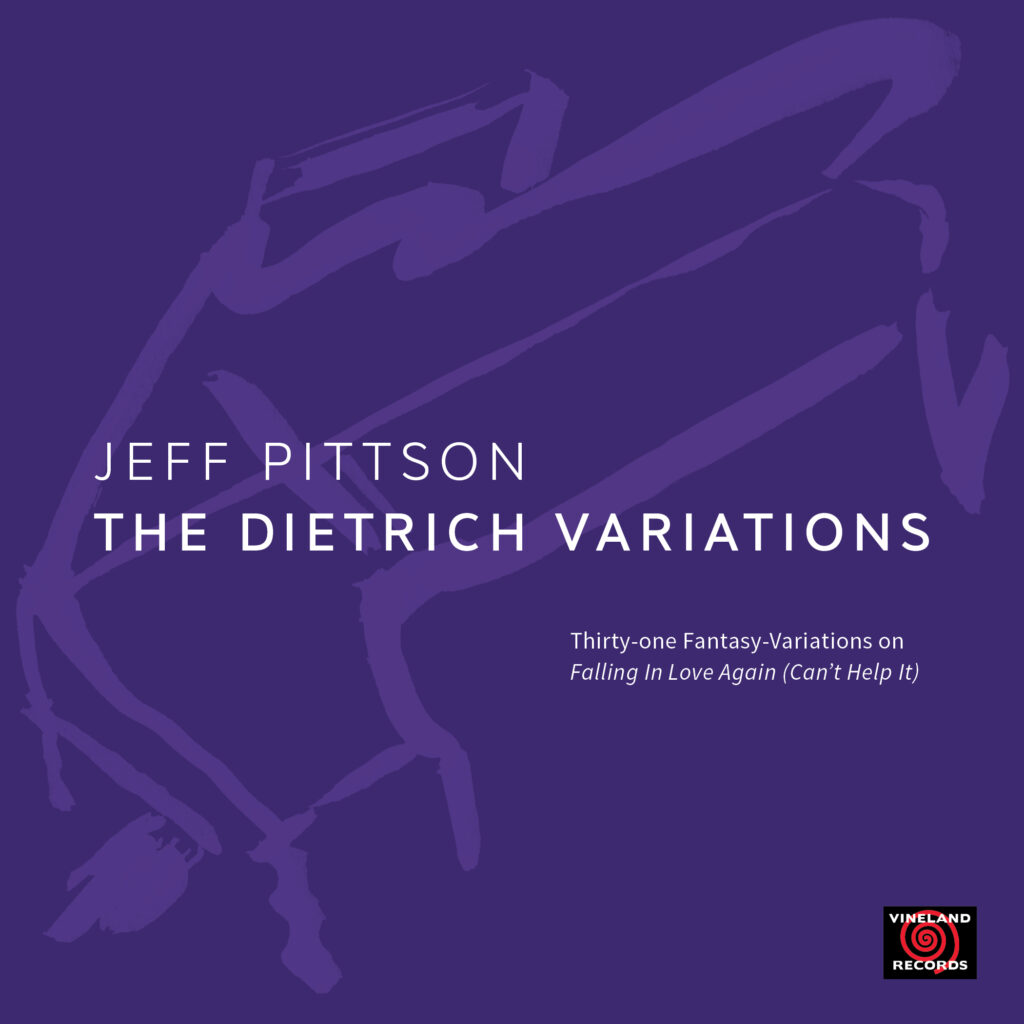
The Dietrich Variations
Thirty-one Fantasy Variations on “Falling in Love Again (Can’t Help it)”
1. Theme: Falling in Love Again (Can’t Help it)
2. Lonesome Love
3. Westworld
4. Exile Rhapsody
5. Hamburg
6. Mysterium
7. Night Intervals
8. Watercolors
9. Bodhi Tree Satti
10. Third Eye
11. Running Man
12. Eight Winds
13. Preludium
14. Inventio
15. Pianola Duo
16. Opus Posthuma
17. Love Lost Tango
18. Tears In The Rain
19. Les Six
20. Majorca
21. The View From Manhattan
22. Leningrad
23. Shiva
24. Etude In Fifths
25. Microdensities
26. Endlessly Rising
27. Fantasies
28. Flying Dutchman
29. The Starry Sky
30. Fanfare
31. Fin De Siecle
32. Reductio
33. Coda
Jeff Pittson: piano
All music composed by Jeff Pittson, November 2000–March 2001
(Jeff Pittson Publishing, BMI)
except “Falling in Love Again (Can’t Help it”
composed by Frederick Hollander, English lyric by Sammy Lerner
(Pensive Music/Frederick Hollander Music, ASCAP)
Released 2018
Engineering: Dave Bell
Mastering: September 30, 2001, Bellboy Recording, Richmond, CA
Graphic Design: Evan Pittson
Piano Illustration: Jeff Pittson
Liner Notes
“Why tonality as such should be thrown out for good, I can’t see.
Why it should be always present, I can’t see.”
Charles Ives
“Some Quarter-Tone Impressions” from Essays Before a Sonata and Other Writings
The Dietrich Variations, named for the actor Marlene Dietrich, pays homage to composers ranging from the romantic era to those who contributed to that musical explosion known as the twentieth century. From Fin-De-Siecle Vienna circa 1900, Igor Stravinsky with Le Sacre Du Printemps, to the very end of the century, European influenced classical music experienced a sonic “Big Bang” in style, harmony, national influences and textures in which we witness the development of a nearly overwhelming bandwidth of musical variety. The piece is a loosely conceived set of fantasy-variations based on the song by Frederick Hollander and premiered by Ms. Dietrich in the 1930 film Der Blaue Engel (The Blue Angel). Following the film’s success as the first major German sound movie, and establishing Dietrich as an international star, Falling in Love Again (Can’t Help It) became her personal anthem, the signature song of her more than five decade career.
The variations, written in 1999–2000, have a variety of origins: some began as fragments, sketches on paper or in the computer, some as developed lead sheets or short scores; many began as improvisations, either in real-time or by layering through the use of MIDI recording and editing. Some were first takes and others were edited as necessary, trying to follow the software analogy that the best end of the pencil is the eraser. For this recording, the Wersi CP-2 digital piano was connected to an Opcode MIDI interface running into a 1996 Apple Macintosh. The sequencing software was MOTU Performer.
Twentieth century composers since Gustav Mahler have confronted the convergence of tonality, atonality and serialism by utilizing or borrowing from each procedure. For example, Igor Stravinsky and Aaron Copland turned to 12-tone technique rather late in their careers. Alban Berg, while being a serialist, was able to artistically balance elements of tonality and atonality to forge a powerful personal style that remains the most popular of the Second Viennese School. Arnold Schoenberg, the inventor of Twelve-tone technique, at the same time, stated that there is still much great music to be written in C major and wrote tonal music occasionally as late as the 1940s. Elliott Carter began as a tonalist and then developed a highly personalized sonic universe of his own.
Finally, in praise of tonality, Leonard Bernstein, in his sixth and final Norton lecture entitled The Poetry of Earth, asserts that tonality and melody are components of our common “musical earth” that have always been present and always will be. In his opinion our tonal heritage exists at the core of our artistic-spiritual DNA and manifests in a multiplicity of music from around the planet whether classical, popular or indigenous folk.
Special thanks to Walter Gray for introducing me to chamber music concerts as a teen, Jerry Kuderna for being the inspiration for the Dietrich’s, and Wally Schnalle and Dave Bell for their technical support. Most of all, deepest thanks to Suzanne with whom I fell in love again.
Jeff Pittson
Dobbs Ferry, NY
January 2018